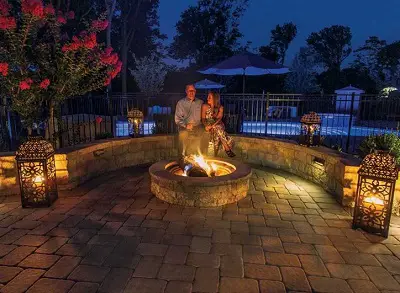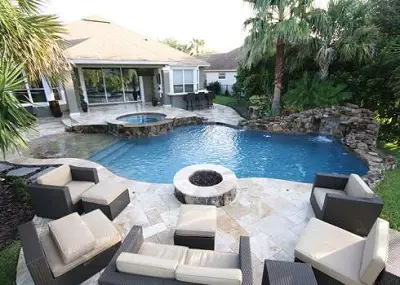When the weather turns cooler, a heat source like a patio, pool-side, or backyard fire pit affords continued outdoor living space enjoyment in spite of the chill in the air. Fire pits are available in a variety of types, including custom-made and pre-fabricated, but no matter what type you choose, safety must be a top priority.
Between 2008 and 2017, the number of injuries caused by outdoor heaters and fire pits actually tripled, partially due to the fact that a backyard fire pit is now one of the most popular outdoor implements on American properties. When you’re dealing with an open flame, you are always dealing with certain risks, both to people and property in the vicinity. Therefore, it’s important to keep a few crucial safety tips in mind before, during, and after you light the fire to thwart any risks involved.
Best Safe Location for a Backyard Fire Pit
Before you purchase a fire pit or have one built, remember to check with your local government to confirm that fire pits of any make or model are legal in your municipality. As far as where to put your fire pit, a few guidelines will make sure you have the safest placement:
- Pick a spot at least 10 feet from any structure, whether it’s your home, a neighbor’s fence, or an outbuilding
- Avoid placing a fire pit near low-hanging tree limbs, nearby shrubs, or other vegetation that could ignite
- Fire pits need a stable spot for setup, so the area should be level and offer solid support
- Consider placing the fire pit on a gravel, paved, or stone-covered surface instead of on a wooden deck
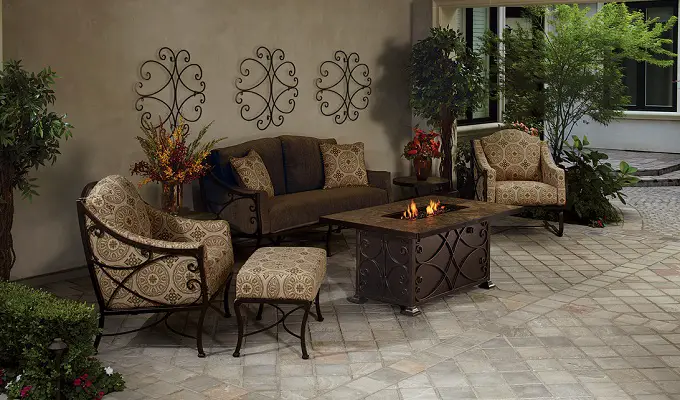
11 Fire Pit Safety Tips to Follow
1. Choose the right fuel.
Select the proper heat source for your fire pit. If it is a pre-fab model, the manufacturer will list the correct type of fuel to use. If you plan to have one custom-built, work with your landscape architect to determine what fuel sources should be used. Depending on the design and components, fire pits can be fueled by hardwoods like cedar and oak or they can be outfitted with burners that rely on natural gas, propane, or alcohol-based fire gel.
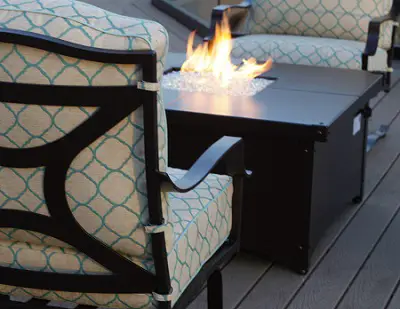
2. Make sure your fire pit is on a stable, fireproof floor
Your fire pit must be placed on a surface that can handle sparks or embers that might blow from the bowl. Any natural stones, like flagstone, travertine, slate, and granite, and manmade materials like concrete and durable fire-safe paving stones, are excellent choices.
Avoid grassy, vegetated areas that could ignite. Likewise, the implementation should be aptly supported by a solid surface. If you are using a prefabricated fire pit, it should be placed on level ground to prevent the risks of tipping over.
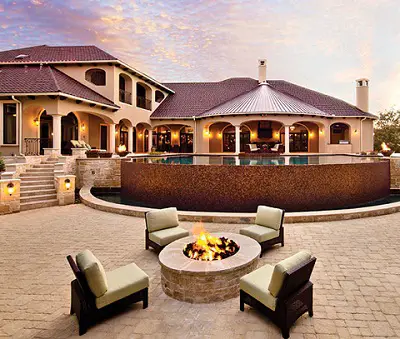
3. Keep your fire pit away from anything flammable.
The rule of thumb is to maintain at least 10 feet of space between the fire pit and anything combustible. That means, when you use the fire pit, keep furniture and accessories at a safe distance. Keep clutter away from the general vicinity as well. The more items you have in the area, the easier it can be for a misguided spark to cause a fire.
4. Check weather conditions before lighting the fire pit.
Never light a fire pit in windy conditions. Not only will you have difficulty starting the fire, but you will also have a greater chance of flying embers or sparks blowing away from the controlled area. Wood-burning fire pits are especially notorious for sending embers into the air, while gas and gel types are less likely to be affected by the wind.
5. Keep your fire low and slow.
Be patient. If you are using wood in your fire pit, start the fire slowly. Once the fire is burning strongly, add more fuel until you have the level of heat you desire. A low and slow-burning fire is more controllable and less likely to send out embers. Likewise, keeping the gas flames turned down low keeps the flames at a more manageable height.
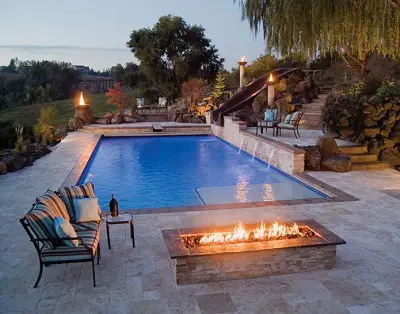
6. Use a mesh cover.
A good way to keep embers and sparks from flying out of the pit is to contain them from the beginning, and a wire mesh cover is a great option. The warmth and ambiance remain intact while the fire pit area has one more line of defense against unsafe conditions.
Most pre-fabricated fire pits come equipped with a mesh cover, but if you have one custom-built, you can still order universal mesh covers or work with a steel fabricator to get what you need.
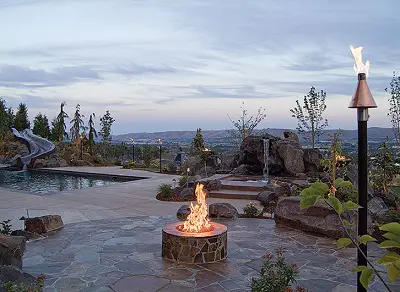
7. Never neglect your fire pit
No matter the fuel, always stay with the burning fire. If you are using wood, keep a container of water or fire extinguisher on hand just in case you need to contain a flare-up.
If your fire pit is fueled by propane, natural gas, or gel, read the manufacturer’s instructions regarding fire extinguishing. Usually, all it takes is a turn of the knob to cut off the fuel supply and extinguish the fire, but you may also be able to use a fire extinguisher with the gas shut off, sand to snuff out a major flare-up, or even a fire blanket.
8. Watch out for loose-fitting clothing
When lighting a fire pit or standing near it, be mindful of loose-fitting clothing, dangling accessories, and even long hair. Something like a nylon scarf can go up in flames in the blink of an eye, and even hair coated with something like hairspray can be extremely flammable.
9. Be mindful of fire pit safety with children and pets
Children can enjoy a warm, crackling fire just as much as adults. However, children are much more likely to suffer burns because they don’t always understand the risks involved. If you are around the fire pit with children, be sure they are monitored at all times. Don’t allow them to stick items into the open flames and teach them that the flames and structure supporting the fire can be hot enough to burn.
If you are enjoying a fire with pets, make sure they are leashed. While most animals will not get close enough to fire on purpose to get burned, a hot ember could get in their fur, or a misguided animal could bump into a pre-fab fire pit and cause it to topple over.
10. Avoid the temptation to use accelerants
Never use an accelerator on your fire to get it going, such as gasoline, alcohol, or oil—accelerants can be unpredictable and risky. Also, mixing accelerants with gas or gel-powered fuel can lead to chemical composition changes that cause major flare-ups and unsafe residual chemicals to be released in the air.
11. Always make sure the fire is out before you leave the area
When you are finished with the fire pit, take precautions to make sure the fire is entirely out. If you used wood, smooth the ashes and let them cool. Then, gently pour water over the cinders. Look for hot spots or smoldering embers; once the fire pit is fire-free, you can exit the area.
Never assume a fire is going to just go out on its own or be just fine on its own, even if it’s raining. With a gas fire pit, be sure the shut-off valve is turned off and watch for flames to die out. With fire gel, follow the manufacturer’s guidelines for snuffing out the flames before walking away.
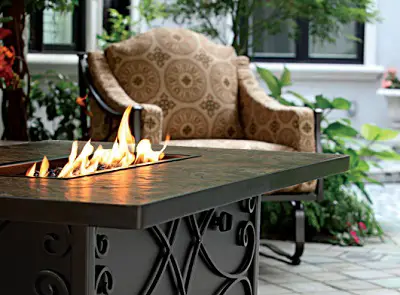
Fire Pit Safety By Fuel Type
Propane and natural gas fire pit safety
Propane or gas-fueled fire pits are incredibly convenient, but safety is still something to remember. You are dealing with a highly combustible gas with either type, so you do have to take a few extra safety steps. A few tips to remember with propane or natural gas fire pits include:
- Keep the burner and pipes clean
- Monitor the fire pit for leaks before ignition
- Keep access to the shut-off valve open
- Never add paper or combustible material to the fire
Wood fire pit safety
Here are a few good fire pit safety tips to consider if you are using wood:
- Burn only dry, seasoned wood with low moisture content for a clean, hotter burning fire
- Keep any nearby stacked wood covered
- Don’t burn treated lumber, construction materials, painted wood, or plastics in the fire pit
- Be mindful of local burn bans and burn ordinances, especially during wildfire season
Another tip, don’t burn softwoods like cedar or pine. Most fire pit manufacturers advise using hardwoods only because softwoods are more likely to throw sparks.
Gel fuel fire pit safety
Gel fuel is alcohol-based, and usually, the gel itself is in a container or reservoir within the fire pit. While gel fuel can be preferable because of its clean-burning nature, there are still a few risks. A few safety rules to remember:
- Only use approved fire gel in your fire pit, according to the manufacturer’s guidelines
- Never try to refill disposable fire gel containers; buy a replacement instead
- The initial blue flame can be hard to see, so use a long lighter to keep your hands back if lighting manually
- Make sure the flame is fully snuffed out before leaving the fire pit unattended
- Always allow the gel fuel reservoir to cool before attempting a relight
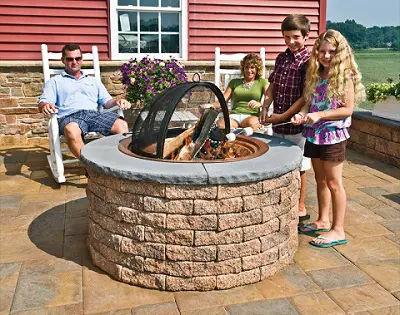
Fire Pit Safety Near a Pool
The allure of pool-side flames in a pool fire pit is undeniable—a fire pit can give your pool area a totally new layer of enjoyable functionality and a nice place to get warm after a nippy swim. While integrating a fire pit near a pool means you will be close to water, you do still have to be mindful of safety.
For the most part, all aforementioned rules still apply to a pool-side fire pit with a few extra caveats. Even though your fire pit is near water, you do still need an extinguisher or hose on hand. Also, a protective mesh screen can be even more important to keep embers from drifting to outlying pool components.
Most property owners prefer gas or fire gel burners for pool-side fire pits because they do burn cleaner. Pool chemicals of any kind should be safely tucked away from the fire, as most are combustible or heat-sensitive.
